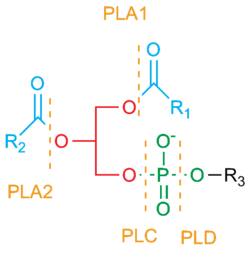Phospholipase A
Phospholipase A is an enzyme that hydrolytically cleaves phospholipids. Phospholipase A is divided into phospholipase A1 and phospholipase A2, they cleave different bonds in the phosholipid. Both are contained in lysosomes and in the digestive tract, where they have a digestive function.
Phospholipase A1[edit | edit source]
An enzyme that cleaves the acyl at position 1 in a phospholipid.
Phospholipase A2[edit | edit source]
It cleaves the acyl in position 2 from the phospholipid. Unsaturated fatty acids, such as arachidonic acid, are often found in this position. The release of arachidonate is an important step for some signaling pathways – both arachidonic acid itself and other substances derived from it (eicosanoids) have a signaling function. Enzymes with phospholipase 2 activity are also part of the venom of some snakes and spiders. The rest of the phospholipid that remains after sn-2 fatty acid cleavage (lysophospholipid) in the extracellular space has a haemolytic effect. After being bitten by some species of snakes and spiders, acute, even fatal, intravascular hemolysis can occur. In humans, extracellular phospholipase 2 is produced in pancreas as a proenzyme, it requires trypsin and Ca2+ ions for its activation.
Links[edit | edit source]
Related articles[edit | edit source]
Used literature[edit | edit source]
- LEDVINA, Miroslav – STOKLASOVÁ, Alena – CERMAN, Jaroslav. Biochemie pro studující medicíny. 2. edition. Karolinum, 2009. 269 pp. pp. 178. ISBN 978-80-2461-414-4.
- MATOUŠ, Bohuslav. Základy lékařské chemie a biochemie. 1. edition. Galén, 2010. 540 pp. pp. 151. ISBN 978-80-7262-702-8.



